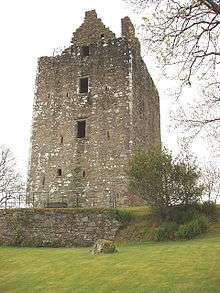Cardoness Castle
| Wikimedia Commons has media related to Anwoth, Kirkcudbrightshire. |



In AD1220 an old Cardoness Castle was noted in records, when a Nicholas de Kerdenes and his wife Cicely were in dispute with the monastery at Dundrennan over Cicely's dowry - the litigation went on for over 20 years. Nicholas was probably descended from one of a number of Anglo-Norman lords who were persuaded by the King of Scotland to settle in the area in an attempt to reduce the power of the Lords (King) of Galloway (MacDowalls). The newcomers were well advised to build strong castles and many of these fortresses survive.
In AD1277 Bertram de Kerdennes was a witness to a charter by King Alexander III (reigned 1249-1286)confirming a grant by Devorguilla de Balliol ( step-sister of Thomas of Clan MacDowall of Garthland Stoneykirk Wigtownshire ) to Glasgow Cathedral and in AD1282 Sir Bertram de Kerdennesse was a witness to the surrender by Robert de Campania to Devorguilla, of all his lands in Borg (Borgue, Stewartry of Kirkcudbright).[1] note: McCulloch of Ardwell, Stoneykirk, Wigtownshire was a neighbour of McDowell of Garthland, Stoneykirk.
On 18 June 1342 Sir Malcolm Fleming had a charter of the lands of Kerdones (Cardoness), in Galloway, from King David II in excambion for the lands of Mochrum which the King had formerly given him, and three other charters from said monarch of the lands of Lenzie, Kilmaronoch, and the barony of Dalliell in free warren, the lands of Rinnes of Wigtown, and the lands of Sithboger in the barony of Lenzie forfeited by Thomas Balcasky. He married a lady whose Christian name was Marjorie, to whom cloth and furs were given by the King in 1329. Malcolm Fleming, the King's esquire, and Marjorie his wife, the King's nurse, died about 9 November 1343, and there is a note of a charter of lands in the sheriffdom of Dumfries to Malcolm Wallayis (Wallace), said to be resigned by Marjorie Fleming, Countess of Wigtown, foster-sister to King David II, but this was probably her daughter Marjory. The Scots Peerage VIII:520-522]
Tradition asserts that in the 15th century an heiress of the de Kerdernes family married a McCulloch (from Wigtownshire)) and tells a grim and dramatic tale of how she became the last of her race.[2] "A certain laird of Cardoness, having exhausted his resources in the building of his castle , joined a band of Border thieves and amassed considerable property by plunder. During twenty years of married life his wife had borne him nine daughters; but this did not satisfy his now increased anxiety to perpetuate his name, and he threatened his lady that, unless at her approaching confinement, she produced a son, he would drown her and all her nine daughters in the Black Loch and look out for another wife. The probability of his carrying out this threat was not doubted for a moment, and hence great was the joy of the lady and her neighbours when she actually presented her husband with a boy. It was now midwinter (c.1395) and the lake was firmly frozen over so the Laird announced his determination of giving a grand fete on this same Black Loch. In accordance with his orders, on a certain Sunday, his whole family was there assembled, excepting one daughter, who was unable to join the party(some versions of the story state that she was attending her mother at home). The revels were at their height when, suddenly the ice gave way, and the old "de Kerdernes" was plunged himself into the dark waters, and perished miserably with all his family, only excepting the one young lady, who, having thus narrowly escaped the same fate, shortly after, married one of the McCullochs".
Cardoness Castle is a well-preserved 15th Century tower house, in Anwoth Civil Parish area, just south west of Gatehouse of Fleet, Kirkcudbrightshire, Galloway south west Scotland owned by the MacCulloch family of Galloway also known as the MacCullochs of Myreton, Wigtownshire.[3][4]
By 1628 Cardoness belonged to John Gordon Clan Gordon, head of a family with whom the McCullochs had long feuded. In 1690 Sir Godfrey McCulloch shot dead John Gordon's son, William Gordon. Sir Godfrey escaped to France, but was spotted in Edinburgh in 1697 and beheaded on the Maiden, the Scottish equivalent of the guillotine.
Cardoness Castle passed through the hands of a number of owners before being placed in State care in 1927.
Today it is cared for by Historic Scotland.
Fleet Bay can be seen from its battlements. It is now in the care of Historic Scotland.
References
- ↑ "Registrum Episcopatus Glasguensis; Munimenta Ecclesie Metropolitane Glasguensis a Sede Restaurata Seculo Incunte Xii Ad Reformatam Religionem". archive.org.
- ↑ Hereditary Sheriffs. by Agnew https://archive.org/stream/hereditarysherif01agne/hereditarysherif02agne_djvu.txt
- ↑ http://mccullohreunion.org/?page_id=585
- ↑ "Scottish Castles Photo Library - Cardoness Castle, Cardoness Castle, Dumfries and Galloway". rampantscotland.com.
External links
- Cardoness Castle – site information from Historic Environment Scotland
- http://canmore.rcahms.gov.uk/en/site/63632/details/cardoness+castle/
Coordinates: 54°52′20″N 4°11′53″W / 54.8723°N 4.1980°W